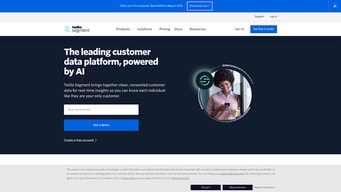

Unclaimed: Are are working at Segment ?
Segment Reviews & Product Details
Segment is a customer data platform that consolidates data from multiple sources to provide real-time insights and enhanced customer profiles. It enables businesses to personalize customer interactions by using AI-driven predictions and recommendations. Segment offers tools and integrations that help streamline data collection, management, and activation for targeted marketing campaigns and customer relationship management.

( 1 )
| Capabilities |
|
|---|---|
| Segment |
|
| Ease of use |
|
| Deployment | Cloud / SaaS / Web-Based |
| Support | 24/7 (Live rep), Email/Help Desk, FAQs/Forum, Knowledge Base |
| Training | Documentation |
| Languages | English |



Segment allows us to quickly and efficiently route our data from production to various other locations such as mix panel or S3 as needed. Currently, all our required platforms are supported.
It works as advertised, so I honestly don't have any complaints.
When data we want captured or desired events occur on our platform segment allows us to capture them and route them to the necessary services and storage locations. If we didn't have a tool like this, we would have to write custom integrations for everything, significantly increasing the development time.
The personas feature is extremely helpful to be able to follow a user through their full customer journey. This can then be used to build audiences using on site data and send to downstream tools like facebook or google ads, or connect to a data ware house for further analysis. For example, based on this customer journeys you can work on an attribution model using first party data. Also, Segment's UI is very easy to use and understand and there is a lot of documention to work with.
The personas feature is not part of the Connections feature in Segment, so it requires an additional purchase/plan if you want the single view of a customer.
Segment is giving non technical teams the possibility to be able to send collected data to destination such as Facebook or Google Ads without the need of a dev source. It also, gives the ability to really leverage collected data for audience building, communication and behavioral analytics.
Segment enables us to control the sources and destinations for our data while serving a critical enabling function around privacy and data governance. It makes a LOT of data plumbing easy and easier to do the right way.
Segment is a large bill that scales with usage. I wish there was better support during source/destination setup for understanding if enabling something would add cookies.
Segment solves 2 problems: 1) Makes plumbing data a lot easier 2)Makes it far easier to handle privacy requirements
Segment is doing a great job abstracting and managing a client platform's complexities, including all the known challenges of ingesting real-time streaming data and handling multiple sources to multiple destinations. The management of data sources and destinations is very intuitive and easy. Also, creating new, non-native sources and targets using the Functions feature is very helpful. Using "SQL traits", we keep many complex users attributes in sync across our core business and CRM platform.
Some recent changes in UI are a bit confusing. We miss the SQL server support for the warehouse. In general, due to the Function feature, we can create any missing source and destination we need.
Segment solves all problems in creating and maintaining a data platform with a small team. It's very robust, feature-rich, and has a fantastic support team (really, they are overwhelming). Using Segment, we can keep our customers close, helping us provide better products.
Being able to visualize the connection points between data inputs and outputs is extremely helpful for understanding how our data connections relate.
There is a decent learning curve to understanding the system, but there are definitely less user-friendly systems out there.
It helps me to funnel events from disparate systems and send them to downstream data sources. Additionally, creation of customer segments/personas helps to understand the user base and target marketing, outreach, etc. effectively.
As a product manager, Segment allows me to get a great understanding of where data is coming from, and where it is flowing to. This allows me to make my data-based decisions far more confidently, as I am sure it is both coming from the right place & is accurate.
There is not much to dislike, segment has really made my job easier in terms of data needs. One recommendation would be the ability to see a longer history of violation history on the home page. Currently, you can only see 24 hours or 7 days. I would also like the option top see the past 30 days.
The biggest problem segment solved for us was the ability to nail down events for specific actions within our product, and be certain e had the right data on usage at that moment, as well as over time. A big use case of our segment events is to judge user behavior over an extended period of time, so we can understand what leads to conversion, churn, or many other outcomes. Segment has allowed us to not only set up the events necessary to track these, but also be confident in the data we are collecting.
Really easy to setup new sources and new destinations. They have so many integrations out of the box that it's really rare you don't have what you need. Debugger tool is quite handy. I'm always amazed when I discover a team not knowing Segment and wondering if they could benefit from it. It just saves so much time.
Based on your permissions sometimes you don't see some sources or destination, but you don't know they're there. Just something stating that some stuff is not displayed would help stop pinging teammates.
It's helping us collect all the data from all third party tools and send it everywhere we want, very easily. Basically you don't have to wonder if or how you'll connect 2 apis to pass some data from one tool to another. Saves a lot of time.
I've been using Segment Connections for a while now, and the product has delivered on the core promise every single time. Built-in connections with the various platforms make it so easy to implement. The need for tech professionals' help is minimal, as the documentation is well structured and one can find answers to almost everything there. Even if some questions remain un-answeres, the support is always there for you. That creates immense opportunities for business people to use the power of data to support the growth of their business at any stage.
Even though the free tier provides solutions for many challenges, there's still inconsistency with scheduling the destination data syncs. You can't plan a sync whenever you need; it's under a paid tier. There's a workaround, but I believe offering the sync scheduling option would be a huge relief for users still using the free version.
Segment Connections make data collection incredibly easy. Thus businesses can benefit from the power of data at any stage of development. Not even mentioning the power of having data from various sources under one roof.
I like the fact that I can track events at real time with very minimal integration needed on my end. The SDKs provided make it very easy to integrate and use the product.
I love the product so far. Not yet used it long enough to find something I do not like. Only used the tracker so far and it works well.
I would like to track user events both in the backend and the frontend. Segment allows me to asynchronously fire events with information that I can then use to understand user behaviour and improve.
It's so easy to setup Segment sources and destinations. And there are so many native integrations there's almost always a solution built right in.
The way usage is measured can be confusing. We don't always know how close we are to our plan limits and what factors are driving it.
We have many inter-related systems that need to share data. Segment is a great tool for tying all of those systems together and keeping them in sync.